Kia Sportage: Headrest for front seat
The driver's and front passenger's seats are equipped with a headrest for the occupant's safety and comfort.
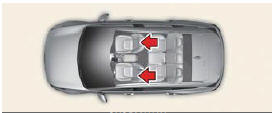
The headrest not only provides comfort for the driver and front passenger, but also helps protect the head and neck in the event of a rear collision.
For maximum effectiveness in case of an accident, the headrest should be adjusted so the middle of the headrest is as high as the center of gravity of an occupant's head. Generally, the center of gravity of most people's head is similar with the height of the top of their eyes.
Also, adjust the headrest as close to your head as possible. For this reason, the use of a cushion that holds the body away from the seatback is not recommended.
WARNING
Headrest removal/adjustment
- Do not operate the vehicle with the headrests removed. Headrests can provide critical neck and head support in a crash.
- Do not adjust the headrest height while the vehicle is in motion. Driver may lose control of the vehicle.
CAUTION
Excessive pulling or pushing may damage the headrest.
Adjusting the height up and down
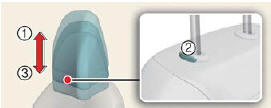 To raise the headrest:
To raise the headrest:
- Pull it up to the desired position (1).
- To lower the headrest, push and hold the release button (2) on the headrest support.
- Lower the headrest to the desired position (3).
NOTICE
If you recline the seatback towards the
front with the headrest and seat cushion
raised, the headrest may come in contact
with the sun visor or other parts of
the vehicle. 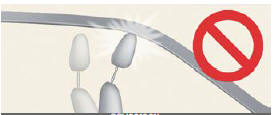
Removing headrest
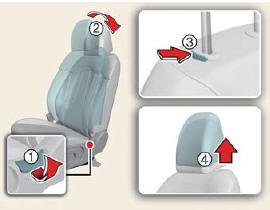
Type A
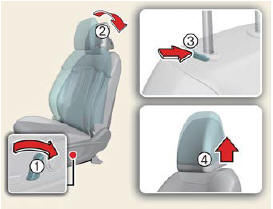
Type B
To remove the headrest:
- Recline the seatback (2) with the recline lever or switch (1).
- Raise headrest as far as it can go.
- Press the headrest release button (3) while pulling the headrest up (4).
WARNING
Removing headrest
NEVER allow anyone to ride in a seat with the headrest removed or reversed.
Headrests can provide critical neck and head support in a crash.
Reinstalling headrest
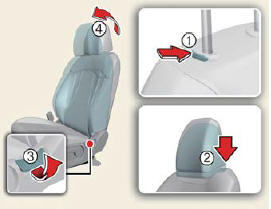
Type A
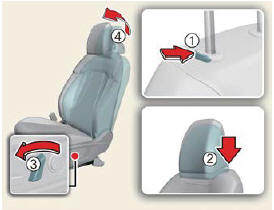
Type B
To reinstall the headrest:
- Put the headrest poles (2) into the holes while pressing the release button (1).
- Recline the seatback (4) with the recline lever or switch (3).
- Adjust the headrest to the appropriate height.
WARNING
Headrest Reinstallation
To reduce the risk of injury to the head or neck, always make sure the headrest is locked into position and adjusted properly after reinstalling.
Seatback pocket (if equipped)
There is a pocket (1) in the front seat
back for storing simple books or atlases,
and USB charger (2) (if equipped) for
rear passengers. 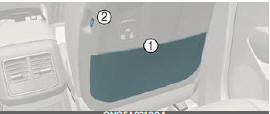
WARNING
Seatback pockets
Do not put heavy or sharp objects in the seatback pockets. In an accident they could come loose from the pocket and injure vehicle occupants.
READ NEXT:
 Headrest for rear seat
Headrest for rear seat
The rear seat is equipped with headrests
in all the seating positions for the occupant's
safety and comfort.
The headrest
not only provides comfort
for passengers, but also helps protect
t
 Folding the rear seat
Folding the rear seat
The rear seatbacks may be folded to
facilitate carrying long items or to
increase the luggage capacity of the
vehicle.
WARNING
Folded Seatback
The purpose of the fold-down rear seatbacks
is to
SEE MORE:
 Ignition System
Ignition System
Description and Operation
Description
Ignition timing is controlled by the electronic control ignition timing
system. The standard reference ignition timing
data for the engine operating conditions are preprogrammed in the memory of the
ECM (Engine Control Module).
The engine operati
 Windshield Glass
Windshield Glass
Components and Components Location
Components
Windshield side
molding
Windshield glass
Repair procedures
Replacement
Removal
CAUTION
Put on gloves to protect your hands.
Use seat covers to avoid damaging any surfaces
1. Remove the following items
Front pilla
Content
- Home
- Kia Sportage - Fifth generation (NQ5) - (2022-2025) - Owner's Manual
- Kia Sportage - Second generation (JEKM) (2005-2015) - Body Workshop Manual
- Kia Sportage Third generation (SL) - (2011-2016) - Service and Repair Manual
- Sitemap
- Top articles